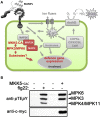Cellular reprogramming through mitogen-activated protein kinases
- PMID: 26579181
- PMCID: PMC4625042
- DOI: 10.3389/fpls.2015.00940
Cellular reprogramming through mitogen-activated protein kinases
Abstract
Mitogen-activated protein kinase (MAPK) cascades are conserved eukaryote signaling modules where MAPKs, as the final kinases in the cascade, phosphorylate protein substrates to regulate cellular processes. While some progress in the identification of MAPK substrates has been made in plants, the knowledge on the spectrum of substrates and their mechanistic action is still fragmentary. In this focused review, we discuss the biological implications of the data in our original paper (Sustained mitogen-activated protein kinase activation reprograms defense metabolism and phosphoprotein profile in Arabidopsis thaliana; Frontiers in Plant Science 5: 554) in the context of related research. In our work, we mimicked in vivo activation of two stress-activated MAPKs, MPK3 and MPK6, through transgenic manipulation of Arabidopsis thaliana and used phosphoproteomics analysis to identify potential novel MAPK substrates. Here, we plotted the identified putative MAPK substrates (and downstream phosphoproteins) as a global protein clustering network. Based on a highly stringent selection confidence level, the core networks highlighted a MAPK-induced cellular reprogramming at multiple levels of gene and protein expression-including transcriptional, post-transcriptional, translational, post-translational (such as protein modification, folding, and degradation) steps, and also protein re-compartmentalization. Additionally, the increase in putative substrates/phosphoproteins of energy metabolism and various secondary metabolite biosynthesis pathways coincides with the observed accumulation of defense antimicrobial substances as detected by metabolome analysis. Furthermore, detection of protein networks in phospholipid or redox elements suggests activation of downstream signaling events. Taken in context with other studies, MAPKs are key regulators that reprogram cellular events to orchestrate defense signaling in eukaryotes.
Keywords: MAPK substrates; chemical defense; metabolome; phosphoproteome; phosphorylation.
Figures


References
Publication types
LinkOut - more resources
Full Text Sources
Other Literature Sources

